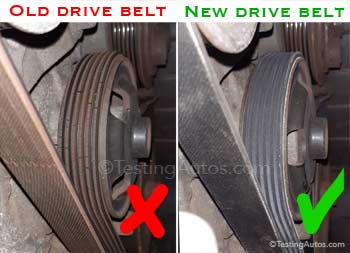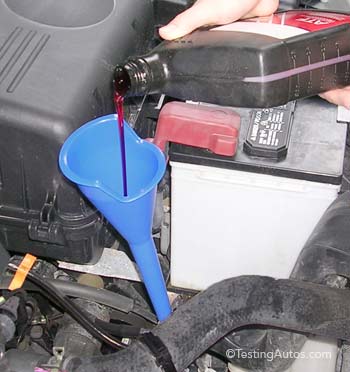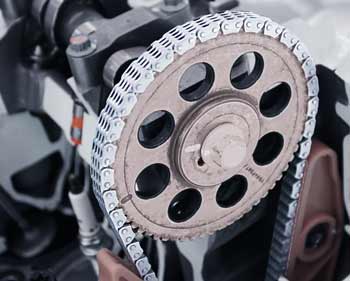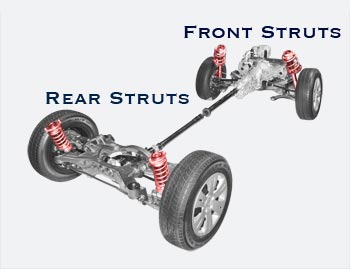When should a drive belt be replaced in your car?
Updated: November 05, 2022
There are several mechanical accessories attached to the engine in a car, such as an alternator, water pump, power steering pump and an A/C compressor.
 Drive (serpentine) belt. See also: Fig1.
Drive (serpentine) belt. See also: Fig1.Most cars have one or two drive belts. A single drive belt is often called a serpentine belt. The drive belt is made of long-lasting rubber-based material, but it still wears over time.
When should a drive belt be replaced? The drive belt should be replaced if it's damaged, stretched or worn out. It's also a good idea to replace a drive belt every 60,000-70,000 miles as part of preventative maintenance because an old, worn-out drive belt can break without warning.
Most car manufacturers don't specify the mileage for drive belt replacement, but advise to have the belt inspected during regular services. If in doubt, ask your mechanic to check the drive belt(s) during your next oil change. The drive belt condition can be checked visually.
How long can a drive belt last? We have seen many cars and trucks in which a drive belt lasted for over 100k miles, but we have also worked on cars in which the drive belt broke before 60K miles.
In fact, if the drive belt breaks while driving, the charging system warning light is the first possible sign that can alert the driver.
Signs that the drive belt should be replaced:
1. The belt is damaged or split.
2. The belt is soaked in oil.
3. The belt shows cracks, missing chunks.
4. Glazing of the belt.
5. Squealing, chirping noises from the belt.
When you bring your car for service, these are the signs your mechanic will look for. Usually, it's easy to see if the belt is worn out. For example, we took this old vs new belt photo before and after replacing the drive belt in this Mazda. As you can see, the old belt in the photo shows cracks in the ribbed side.
One of the early signs that the drive belt is wearing out in your car is when it starts squeaking in rainy weather.
The drive belt is soaked in oil: Another common reason to replace a drive belt is when it's soaked in oil. Oil damages the rubber material, like in the last photo in the set above. If the drive belt is saturated in oil, the oil leak will need to be repaired first. If you install a new belt without repairing the oil leak, the oil will damage the new belt and it will break or slip off again.
Drive belt tensioner: To work properly, the drive belt must be under proper tension. In many older cars, the belt tension had to be adjusted manually in regular intervals. Modern cars have an automatic spring-loaded or hydraulic belt tensioner that doesn't need to be adjusted. However, even an automatic tensioner can seize up or fail causing the belt to be loose or even to slip out of the pulleys. One common symptom of a loose drive belt is a loud screeching noise that lasts for a few seconds when the engine is started.
If the automatic spring-loaded belt tensioner is sticking or shows signs of excessive wear, it makes sense to replace it together with the drive belt; it takes a little extra labor. A hydraulic belt tensioner might need to be replaced if it's leaking oil.
Drive belt replacement cost: Replacing the drive/serpentine belt may cost from 0.8 to 1.5 hours of labor depending on the car, plus the cost of part, which is usually under $70. Replacing the belt tensioner together with the belt will add the cost of the tensioner (usually under $200) plus 0.3-0.8 hours of extra labor.
Does the drive belt have to be replaced when an A/C compressor or alternator is replaced? No, it's not necessary. However, if it doesn't take extra labor and the old belt shows some wear, it is not a bad idea to replace it too.
Is it easy to replace a serpentine belt as a DIY project? If you have sufficient mechanical skills, proper tools, a belt routing diagram and follow the service manual instructions, it's not very difficult.
Advertisement
If the car has two drive belts, do both belts have to be replaced at the same time? No, it's not necessary. However, in most cases there is little extra labor involved in replacing the second belt. If you only have to pay $20-$40 extra for the second belt, why not get them both done at the same time?
What causes the drive belt to wear sooner? Water, road dirt, excessive heat and oil leaks can cause the belt to deteriorate prematurely. For example, if the splash shield under the engine (engine undercover) is broken or missing, the belt will wear out sooner. A failed drive belt tensioner will also cause the belt to wear out sooner or break/slip off.













